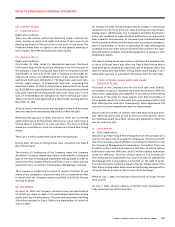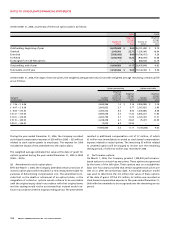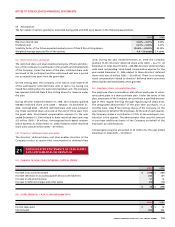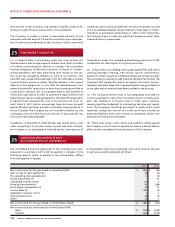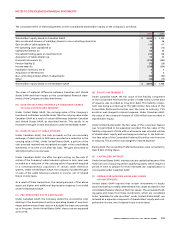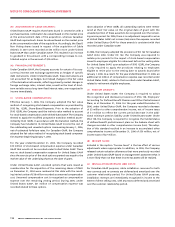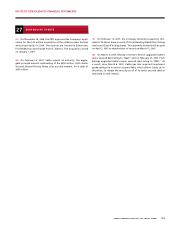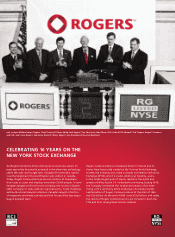Rogers 2006 Annual Report Download - page 114
Download and view the complete annual report
Please find page 114 of the 2006 Rogers annual report below. You can navigate through the pages in the report by either clicking on the pages listed below, or by using the keyword search tool below to find specific information within the annual report.
110 ROG ERS CO MMU N ICAT ION S IN C . 20 0 6 ANN UA L RE PORT
NOTES TO CONSOLIDATED FINANCIAL STATEMENTS
(G) ACQUISITION OF CABLE ATL ANTIC:
United States GAAP requires that shares issued in connection with a
purchase business combination be valued based on the market price
at the announcement date of the acquisition, whereas Canadian
GAAP had required such shares be valued based on the market price
at the consummation date of the acquisition. Accordingly, the Class B
Non Voting shares issued in respect of the acquisition of Cable
Atlantic in 2001 were recorded at $35 million more under United
States GAAP than under Canadian GAAP. This resulted in an increase
to goodwill in this amount, with a corresponding increase to con-
tributed surplus in the amount of $35 million.
(H) FINANCIAL INSTRUMENTS:
Under Canadian GAAP, the Company accounts for certain of its cross-
currency interest rate exchange agreements as hedges of specific
debt instruments. Under United States GAAP, these instruments are
not accounted for as hedges, but instead changes in the fair value
of the derivative instruments, reflecting primarily market changes in
foreign exchange rates, interest rates, as well as the level of short-
term variable versus long-term fixed interest rates, are recognized in
income immediately.
(I) STOCK-BASED COMPENSATION:
Effective January 1, 2006, the Company adopted the fair value
method of recognizing stock-based compensation as prescribed by
SFAS No. 123(R), Share-Based Payments. Prior to the adoption of
SFAS 123(R), the Company used the intrinsic value method to account
for stock-based compensation under United States GAAP. The Company
elected to apply the modified prospective transition method as per-
mitted by SFAS 123(R). In accordance with the transition method, the
Company has included in its United States GAAP income the cost of
the outstanding and unvested options commencing January 1, 2006,
net of estimated forfeiture rates. For Canadian GAAP, the Company
adopted the fair value method of recognizing stock-based compensa-
tion expense beginning January 1, 2004.
For the year ended December 31, 2005, the Company recorded
$35 million of stock-based compensation expense under Canadian
GAAP that would not be recorded under United States GAAP. There
was no stock-based compensation expense for United States GAAP
since the exercise price of the stock options granted was equal to the
market value of the underlying shares at the date of grant.
Under United States GAAP, unvested options that were issued as
consideration for the acquisition of the remaining shares of RWCI
on December 31, 2004 were revalued at this date with the result-
ing intrinsic value of $38 million recorded as unearned compensation
cost. Unearned compensation cost is recognized as compensation
expense over the remaining vesting period. During 2005, under
United States GAAP, $21 million of compensation expense was
recorded related to these options.
Upon adoption of SFAS 123(R), all outstanding options were remea-
sured at their fair value on the original date of grant with the
unvested portion of these awards to be recognized over the remain-
ing service period. For 2006, there is no adjustment required to arrive
at United States GAAP net income (loss) since the expense recorded
under United States GAAP for these awards is consistent with that
recorded under Canadian GAAP.
In 2006, the Company adopted the provisions of EIC 162 for Canadian
GAAP (note 2(b)). Under EIC 162, the Company was required to
restate prior periods for the impact of stock-based compensation
issued to employees eligible for retirement before the vesting date.
For United States GAAP, upon adoption of SFAS 123(R), the Company
is only required to apply the provisions relating to employees
eligible to retire prior to the vesting date to awards issued after
January 1, 2006. As a result, for the year ended December 31, 2006, an
additional $2 million of compensation expense was recorded under
United States GAAP, relative to that recorded under Canadian GAAP,
related to retirement-eligible employees.
(J) PENSION LIABILIT Y:
Under United States GAAP, the Company is required to adopt
the recognition and disclosure provisions of SFAS 158, Employers’
Accounting for Defined Benefit Pension and Other Postretirement
Plans, as at December 31, 2006. For the year ended December 31,
2006, under United States GAAP, the Company recorded a decrease
of $3 million to other comprehensive income, net of income taxes
of $1 million to reflect the current period decrease in the addi-
tional minimum pension liability under United States GAAP. Under
SFAS 158, the Company is required to recognize the funded status
of defined benefit post retirement plans on the balance sheet with
changes recorded in other comprehensive income (loss). The adop-
tion of this standard resulted in an increase to accumulated other
comprehensive income at December 31, 2006 of $50 million, net of
income taxes of $27 million.
(K) INCOME TA XES:
Included in the caption “Income taxes” is the tax effect of various
adjustments where appropriate. In addition, in 2006, the Company
released certain valuation allowances that were previously recorded
under United States GAAP based on management’s assessment that it
is more likely than not that these income tax assets will be realized.
(L) INSTALL ATION REVENUES AND COSTS:
For Canadian GAAP purposes, cable installation revenues for both
new connects and re-connects are deferred and amortized over the
customer relationship period. For United States GAAP purposes,
installation revenues are immediately recognized in income to the
extent of direct selling costs, with any excess deferred and amortized
over the customer relationship period.





